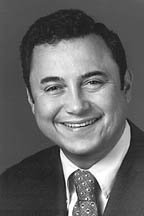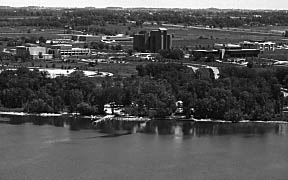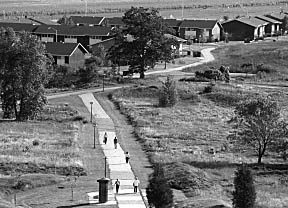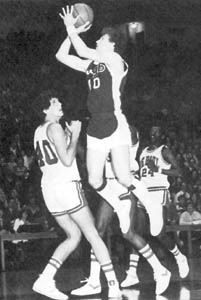Chapter Thirteen: 1979—1980
“In the academic realm, a decade is not a long time. But a decade is time enough for a strong beginning, and UW-Green Bay has made that. Northeastern Wisconsin is a stronger, a better place to live and work and plan for the vagaries of the future because of UW-Green Bay. The school has served well in its years of adolescence. It will serve better in its decades of maturity.” - Press-Gazette editorial, Oct. 14, 1979
Chancellor Weidner was always looking for a reason to celebrate.
Not a shovel of dirt could be turned for a building, in the early years, without a formal groundbreaking. Along the way, Weidner might also choose to lay a cornerstone. And once the final brick was in place, the new structure would be suitably dedicated in the presence of city, county and state officials who were always invited to join the campus community and Green Bay citizenry. So frequent and predictable were these occasions that staff members routinely involved in the arrangements came to identify themselves as the “department of instant ceremonies.”
Strange, then, that Weidner should pass up so obvious an opportunity as a public salute to the 10th anniversary of the opening of the bay shore campus. Perhaps it was because he was “scooped” by the Press-Gazette.
After a decade of scrupulously objective reporting and sometimes skeptical editorializing—reflecting the wait-and-see attitude of much of Northeastern Wisconsin—the Green Bay daily exploded with a fanfare for the young University.
Folded into the edition of Sunday, Oct. 14, 1979, was a 12-page, ad-free supplement all about “UW-Green Bay: The First Decade.” The work of 12 of the paper's most knowledgeable reporters, the section provided exhaustive stories on nearly every aspect of campus programs and activities. Some pieces highlighted history: the role of the UW Green Bay Center, the site controversy, the evolution of the special mission concept, the lingering damage of the earliest, extravagantly optimistic enrollment projections. Another focused on the University's economic impact on the community. Still other articles detailed progress in different areas. Headlines hint at the content: “A healthy job picture: 93 percent of grads working”; “Vexing verbiage finally reshaped for the masses”; “Graduate program reaches out to business community”; “Student attrition rate beginning to slacken”; “Encouraging signs in skills of new freshmen.”
In interview after interview, campus officials provided information and spoke their minds. Associate Chancellor Harden argued the need for University-owned housing, commenting on negotiations then in progress for purchase of the privately owned Bay Apartments. Vice Chancellor William Kuepper spoke of his vision for the academic affairs office and confided his major challenge: “How much emphasis do we put on professional programs compared to liberal arts—where we have more people (faculty members) and more programs?” Alumni vignettes—filling half a page, with photos—reflected appreciation for the University's small classes, caring professors and solid career preparation. Student interviews turned up some complaints about the lack of school spirit. But many students cited the chance to hold a job while attending school as “a very important reason” for enrolling at UW-Green Bay.

Vice Chancellor William Associate Chancellor Donald F. Harden, and Vice Chancellor William Kuepper
Weidner had most of a page to himself, to expound his philosophy, reflect on the institution's achievements, and make some predictions for the future. There were encouraging comments from Gov. Lee Dreyfus, advice from UW President Emeritus Harrington, and strong statements of continuing support from community leaders who had fought hard in the 1960s for a four-year campus in Green Bay. The men's basketball program was praised as a “positive tool” in student recruitment, the lectures and performances offerings as a source of new life in the local cultural scene. The stories were informative, the photos varied and attractive. And setting the tone of the “special report” was a full-column introduction:

University Business Office
“Like any 10-year-old, the University of Wisconsin-Green Bay has experienced its share of growing pains,” the column began. “But it's also showing encouraging signs of maturity.” ...
“The campus was being developed on the fringes of the predominantly blue-collar community of Green Bay—a city of 85,000 known for its strong religious heritage, paper mills and professional football team.
“Chancellor Edward Weidner and the other early educational architects of UW-Green Bay hoped that, in time, Green Bay would also be known for its University.
“A decade later, Weidner and many others like what they see on campus. The mood there is decidedly upbeat.”
Bidwell Gage, first president of the UW-Green Bay Founders Association, echoed Weidner's optimism in a concluding paragraph: “In these 10 years, I think the school is only on the threshold of much, much greater value to the community.”
Gage did not have long to wait. The very next year University officials took giant steps across that threshold as they “buttoned up” (in Weidner's phrase) long-pursued goals in curriculum development, student housing and intercollegiate athletics.
Additions to the academic program during 1980 clearly reflected Vice Chancellor Kuepper's commitment to serving regional needs.
Undergraduate majors in social work and environmental planning opened for business in January. In April, after at least three years of planning, UW regents approved a degree completion program in nursing. By September the first courses were in place and 30 registered nurses began their studies toward the bachelor of science in nursing degree. September also marked the beginning of a master's degree program for school teachers and administrators. In cooperation with UW-Milwaukee, courses from the UWM education curriculum would be offered in sequence each semester and during the summer so that graduate students could complete the degree at UW-Green Bay in three years.
Purchase of the Bay Apartments in March from the Inland Steel Development Corporation ended a decade of arguing, cajoling and negotiating for University-owned campus housing. A low-interest, self-amortizing federal loan of $2 million covered the purchase price and included $400,000 for renovations and repairs on the 10-year-old units. The complex was formally dedicated in August and rechristened the University Village Apartments. For Weidner, acquisition of the 550-bed facility provided, at last, authority to supervise and protect the apartments. With the complex in University hands, he predicted, student enrollment would increase significantly. For Harden, chief negotiator in the transaction, the purchase suggested a long-term impact on future campus development.

University Village Apartments
“Once we have the current residence halls (the apartments) filled,” Harden told a Press-Gazette reporter, “we will be in a much better position to go to various philanthropic sources for additional housing funds.”
Important as academic program development and student housing might have been to those inside the University, however, it was the move to Division I in athletics that sparked the most excitement—and controversy—in the community beyond the campus.
The men's basketball team, still a consistent winner under Coach David Buss, had always been a success on the court but a near disaster at the ticket office. For one game in the early years, receipts totaled $88. Only when the 1972-73 Phoenix hosted UW-Eau Claire in the NAIA tournament did the community begin to sit up and take notice. Fans filled the Brown County Arena for the contest against Eau Claire, a perennial State University Conference power. But their enthusiasm failed to carry over to the season that followed, even as the team advanced to the NAIA national quarterfinals. Then in January 1977 Buss managed to bring DePaul to town. The Phoenix won 57-50 before a sell-out crowd.

The following season, with a No. 1 ranking in NCAA Division II, the Phoenix compiled a 30-2 record, dropping only a contest with DePaul during the season and a tournament game to Cheyney State in the Division II national finals.
It was the match with DePaul, ranked No. 4 in NCAA Division I, that kindled the enthusiasm of sports fans. Tony Walter, Press-Gazette sports editor, called the 55-49 loss in Chicago “the most significant event in the 10-year history of the UW-Green Bay athletic program.” Telecast by Green Bay's Channel 11, the game was watched by an estimated 90,000 to 110,000 viewers in Northeastern Wisconsin.
“The 1978 DePaul game was not the turning point for the basketball team, nor the turning point for the athletic department,” Walter wrote. “But the impact on the community increased sharply from that date.” So did the prospects for a program that might eventually pay its way. From total receipts of $1,500 for men's basketball in 1973, income had climbed over $40,000 in 1978-79, when telecasts of post-season tournaments helped to spread Phoenix fever far and wide. Receipts for 1979-80 were expected to reach $80,000.
The string of winning seasons in NCAA Division II fed the fondest hopes of Weidner and a host of community supporters: that the Phoenix could garner success for themselves—and national visibility for the University—as a Division I team. But as of October 1979, when the Press-Gazette published its special report on UW-Green Bay, Weidner remained staunchly noncommittal on the subject. Such a move, he said, would depend on the results of a four-month study of the basketball program that was already in progress.
While University officials surveyed season ticket holders and interviewed community leaders, the Press-Gazette explored the issue in a series that dominated the sports pages seven days in a row.

The 1978 DePaul match kindled Phoenix fever
One piece analyzed the risks of funding, scheduling and community support. The likelihood that UW-Green Bay would initially post losing records for several seasons. The need for the Phoenix to play many of its games on the road, far from a friendly hometown crowd. The slim chances of post-season tournament play, at least for a few years. The probable loss from the team of a number of “local kids”—players who had been standouts at area high schools, whose fortunes were eagerly followed by local fans. A second article probed the “nightmare” of scheduling for a team just getting its foot in the Division I door. Another discussed the reactions of fans and financial backers. In the last segment Weidner expressed his hope that a successful athletic program in Division I might have a positive effect both on the University's enrollment and academic quality. Tax monies would not be used for the program, he reassured the reporter. Nor would student segregated fees or Founders Association funds.
In late November Weidner announced his decision—unanimously confirmed, he said, by key members of the athletic staff and the administration. The University would seek Division I status for the intercollegiate athletic program, beginning with the 1981-82 season. In May 1980, as the academic year ended, the University submitted a formal petition to the NCAA. It was approved a week later.
Positioning the young university in the company of institutions with “big-time” athletic programs—like UW-Madison and Marquette—was a major motivation for seeking Division I status, according to Weidner. Commenting years later on the decision, he pointed to a lesson he had learned at Michigan State and never forgotten.
“I joined the faculty there soon after President John Hannah had taken Michigan State into the Big Ten,” Weidner recalled. “That move made a big difference. It put Michigan State on the map. It fostered a favorable public perception of just about everything the university did from that point on.”
In the same way, he reasoned, a Division I affiliation could help to establish and maintain a separate identity for UW-Green Bay among Wisconsin's public universities.
Weidner reaffirmed his commitment to a Division I program at a June 7 news conference announcing the NCAA action. The University had fulfilled the preliminary requirements, he said: to schedule 85 percent of Phoenix games against Division I opponents during the period 1981-83 and to obtain private funds to finance the program until it could become self supporting.
“Efforts to secure private pledges to the support of the program have reached their first-year goal through commitments from significant community sources,” Weidner announced. But the Division I decision “was not made lightly,” he added.
“(It) is primarily a decision on which the sports fans of Northeastern Wisconsin will vote during the next several years,” he said. “It will be their support at the box office that will determine the viability of the effort.”
Two weeks after Weidner's announcement, Buss hired two new assistant coaches to replace Charles Aslakson, a long-time aide who had resigned in May. Associate Chancellor Harden, recently assigned oversight of intercollegiate athletics, stepped up his schedule of calls on prospective donors. Athletic Director Bruce Grimes huddled with campus communicators to create a new, high-powered advertising campaign. By the time the students returned in September, “Big Stuff” promotional drums were beating out a steady rhythm on radio and television, on billboards all over the county and bumper stickers in campus parking lots. And basketball season tickets were starting to move.